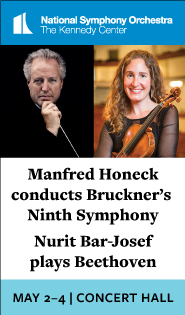Lang Lang’s curious “Goldbergs” stretches Bach to extremes

Lang Lang performed Bach’s Goldberg Variations Monday night at the Kennedy Center.
Lang Lang made a name for himself with a style of playing that divided audiences: was he daring and individualistic or mannered and self-indulgent?
The Chinese pianist, who turned 40 last year, returned to the Kennedy Center Monday night for his first recital since 2015, presented by the National Symphony Orchestra in the Concert Hall. His latest program was perhaps the most aggressively weird of his many strange performances over the years.
The focus of the evening was Bach’s Goldberg Variations, a work he released a double recording of, one live and one made in a studio, in 2020. The first oddness of the evening was opening with Schumann’s Arabeske. If you know you are going to play the Goldberg Variations, often at ostentatiously slow tempos and without an intermission, why prolong the experience any further?
Lang’s take on the Arabeske started with a slow tempo and compounded it with eccentric rubato. The many grace notes in the main theme’s melody could be extended almost to the length of quarter notes. In the contrasting loud sections, his left hand thundered brutally to emphasize the transfer of the tune to the lower octave. Rallentandi were drawn out almost to the point of stasis. It was a preview of the even quirkier Bach that came after it.
This interpretation of the Goldbergs seemed to start with Glenn Gould’s second recording of the work; and then, finding it too speedy and conventional, the pianist sought further extremes. Starting with the Aria, it was not only the tempo choices that puzzled, but the obsession with lingering over almost every mordant. The music often lost direction, sinking under the weight of the attention paid to every small detail.
When Lang opted for a more straightforward approach, as in the first three variations, his playing impressed with its measured accuracy and flair. He insisted on taking all or most of the repeats, further extending the evening, but his switching of emphasis on the repeats from right hand to left, or from loud to soft, at least added variety. In some variations, he made significant changes to the score, adding embellishments and even filling in the harmony, as in the strictly two-part seventh variation.
Starting with the fourth variation, tempos started trending faster and Lang’s touch was often much harsher, leading to clipped articulations in the fourth variation. The fifth variation, the first intended for both keyboards of the double-manual harpsichord for which it was written, was so fast that the lines often blurred together. Lang managed a more flawless crossing of the hands on the grand piano’s single keyboard in the eighth variation, one of the technical highlights of the evening.
As we reached the middle of the piece, Lang’s choices became more and more curious. Abrupt detache articulation marked the fughetta of the tenth variation, played either at a heavy-handed forte or sotto voce. The twelfth variation, the sparkling canon at the fourth, plodded along, exceeded by an even slower thirteenth variation, with some thirds added to the right hand and an obnoxiously loud trill at the final cadence. Lang then went even farther in the glacial reading of Andante in the fifteenth variation.
An explosive start to the Overture of the 16th variation woke up those who had drifted off, the almost robotic touch devoid of nuance. The second half continued in the same vein, with some extravagantly slow movements (no. 21 and especially no. 25) contrasted with variations so rapid (no. 20 and 26) that the sense of meter was lost altogether. Given Lang’s superlative technique, the blockbuster variations from no. 27 to 29 impressed with brilliant fingerwork. The rather plain Quodlibet and repeat of the Aria brought this mammoth performance, lasting over ninety minutes, to its long-overdue close.
Lang’s choice of encores proved the final bizarre touch of the evening, as he played two selections from his latest album of songs from Disney movies, released last summer: “Feed the Birds” from Mary Poppins, arranged by Stephen Hough, and “Reflection” from Mulan. On one hand, arrangements of animated movie pop songs could be construed as the 21st-century counterpart to Liszt’s outrageous paraphrases of themes from popular operas.
On the other hand, Lang’s selection was likely aimed much more at the pint-sized classical music fans dotted throughout the audience, who had been waiting, patiently for the most part, through two hours of abstruse Bach. Lang, whose first child was born in 2021, has commendably lent his name and influence to efforts to bring young people into the fold of classical music. As with his concert staged in front of the fairytale castle at Disneyland last summer, the enfant terrible has found another way to give expression to his inner child.



Posted Feb 09, 2023 at 12:22 pm by Eric Shin
Total Fraud. Always has been and always will be